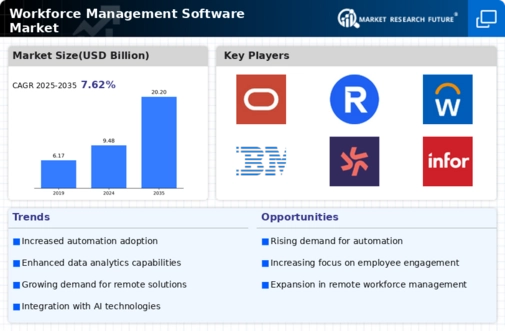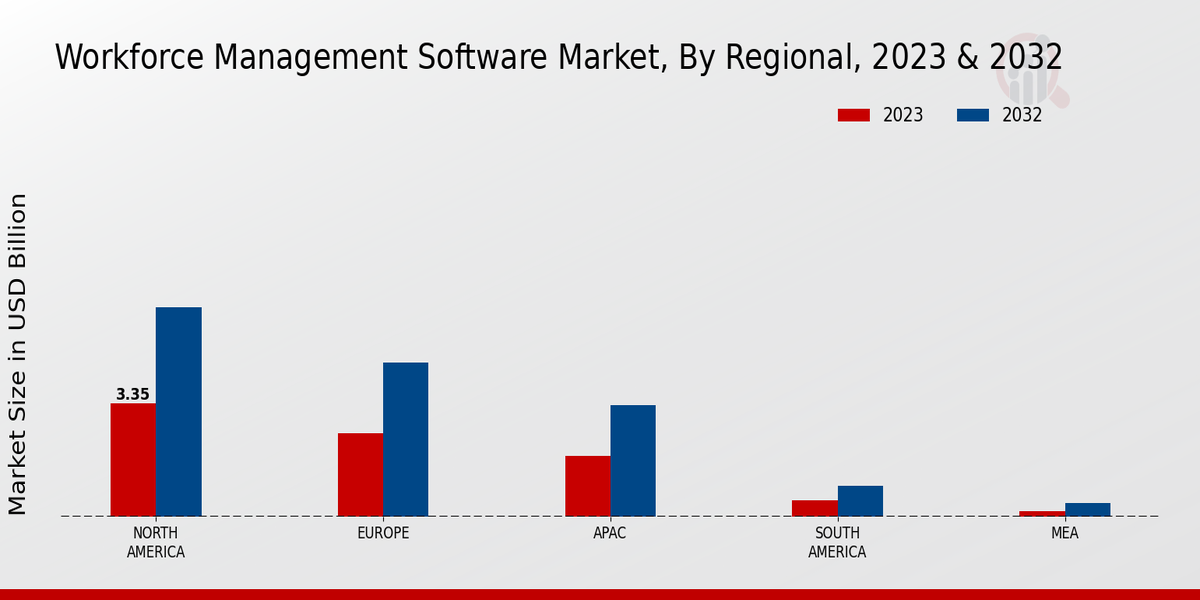Market Growth Projections
The Global Workforce Management Software Market Industry is poised for substantial growth, with projections indicating a rise from 9.48 USD Billion in 2024 to 20.2 USD Billion by 2035. This growth trajectory suggests a compound annual growth rate of 7.11% from 2025 to 2035. The increasing adoption of workforce management solutions across various sectors, coupled with advancements in technology, contributes to this optimistic outlook. Organizations are increasingly recognizing the value of efficient workforce management in enhancing productivity and reducing operational costs. As the market evolves, it is likely to witness further innovations and expansions, reflecting the dynamic nature of workforce management.
Focus on Employee Engagement
Employee engagement emerges as a critical driver within the Global Workforce Management Software Market Industry. Organizations increasingly recognize that engaged employees contribute to higher productivity and lower turnover rates. Workforce management software provides tools for performance tracking, feedback mechanisms, and employee recognition, fostering a culture of engagement. Companies utilizing these solutions often report a 15% increase in employee satisfaction. As the market evolves, the emphasis on engagement is expected to grow, aligning with the projected market expansion to 20.2 USD Billion by 2035. This focus on engagement not only enhances workplace morale but also drives overall business performance.
Increased Demand for Automation
The Global Workforce Management Software Market Industry experiences heightened demand for automation as organizations seek to streamline operations and enhance productivity. Automation tools facilitate efficient scheduling, time tracking, and resource allocation, thereby reducing manual errors and improving overall workforce efficiency. For instance, companies that implement automated workforce management solutions report a 20% reduction in labor costs. This trend is particularly evident in sectors such as retail and manufacturing, where labor optimization is crucial. As the market is projected to reach 9.48 USD Billion in 2024, the drive towards automation is likely to play a pivotal role in shaping the industry's growth.
Integration of Advanced Analytics
The integration of advanced analytics into workforce management software is a driving force within the Global Workforce Management Software Market Industry. Organizations leverage data analytics to gain insights into workforce performance, optimize scheduling, and predict future labor needs. This data-driven approach enables businesses to make informed decisions, enhancing operational efficiency. Companies utilizing analytics-driven workforce management solutions report a 25% improvement in forecasting accuracy. As the market anticipates a compound annual growth rate of 7.11% from 2025 to 2035, the incorporation of advanced analytics is poised to become increasingly vital in shaping workforce strategies.
Emergence of Remote Work Solutions
The rise of remote work solutions significantly influences the Global Workforce Management Software Market Industry. As organizations adapt to flexible work arrangements, workforce management software must accommodate remote monitoring, scheduling, and collaboration tools. This shift necessitates software that can seamlessly integrate remote work capabilities while maintaining productivity and accountability. Companies that adopt remote-friendly workforce management solutions often see a 40% increase in employee productivity. With the market projected to grow substantially, the demand for innovative remote work solutions is likely to drive further advancements in workforce management technology.
Regulatory Compliance Requirements
Regulatory compliance remains a significant driver in the Global Workforce Management Software Market Industry. Organizations must adhere to various labor laws and regulations, necessitating robust workforce management solutions to ensure compliance. Software that automates timekeeping, payroll, and reporting helps mitigate risks associated with non-compliance, which can lead to substantial fines and legal repercussions. For example, businesses that implement compliance-focused workforce management systems experience a 30% reduction in compliance-related issues. As regulations continue to evolve, the demand for software that can adapt to these changes is likely to increase, further propelling market growth.




















